ASUS Eee PC 1005HA: Refining the Netbook
by Jarred Walton on August 20, 2009 4:00 AM EST- Posted in
- Laptops
Netbook Performance Comparison
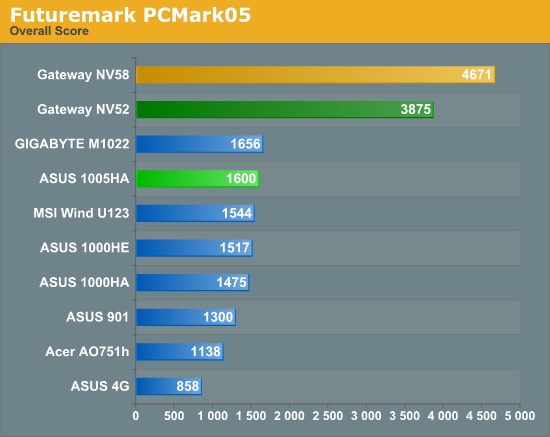
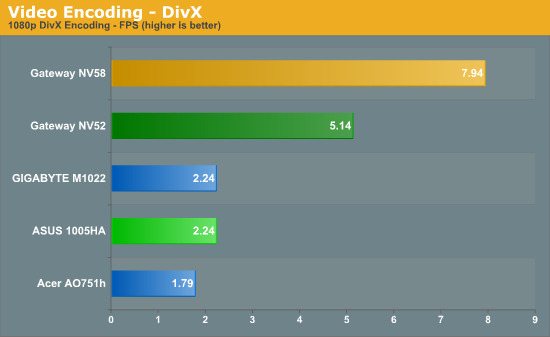
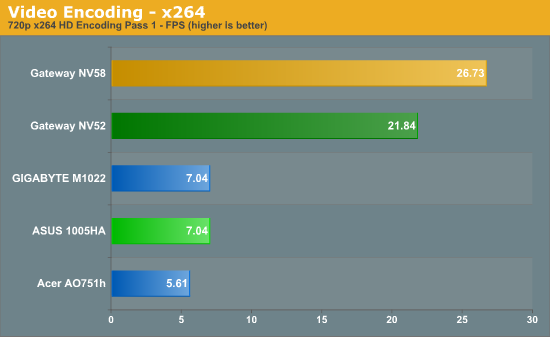
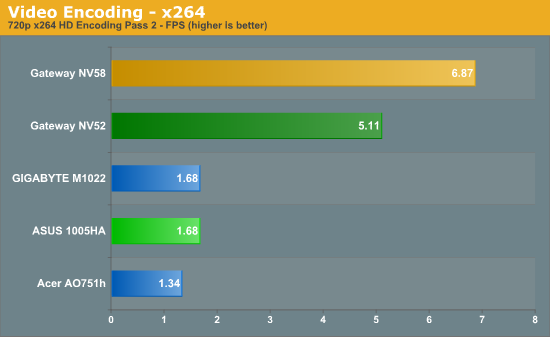
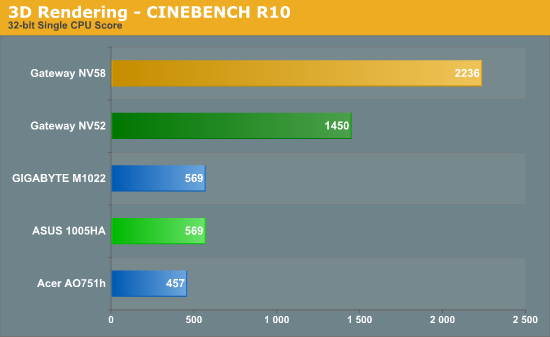
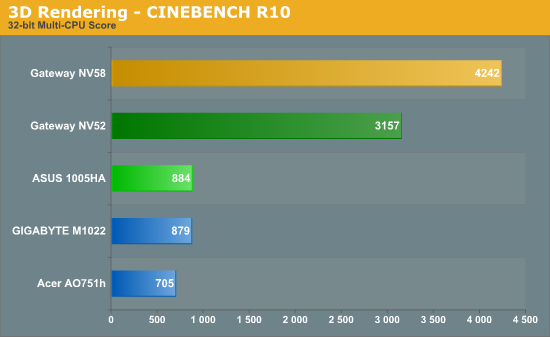
Starting with general application performance, the AMD-based NV52 is 142% faster than the 1005HA and the Intel-based NV58 is 192% faster in PCMark05. If we move to purely CPU limited tasks like 3D rendering and video encoding, the margin is often even greater: NV52 is 130% to 257% faster and the NV58 is 255% to 380% faster. Ouch! Do we even need to explain that the Intel Atom is anything but a high-performance CPU? It's worth noting that none of the netbooks we've tested so far can handle x264 720p (let alone 1080p) decoding; they drop frames like a bad habit. 720p DivX on the other hand works quite well, so we used that for one of our battery life tests on the next page. Update: As one of the readers pointed out, CoreAVC with Media Player Classic will handle x264 720p decode. If that's important to you, the $15 for CoreAVC is a worthy investment. We'll update with x264 battery life decoding results once the tests complete.
 |
The detailed PCMark05 results tell a similar story, with the netbooks trailing entry-level notebooks in nearly every category, often by large margins. Graphics in particular show a huge discrepancy, with the NV52 coming in over 50X faster than the 1005HA in 2D Transparency and 40X faster in 3D Pixel Shaders. Part of the difference comes from OS - XP scores much lower on 2D Transparency than Vista; however, XP also scores higher on HDD tests, which accounts for the netbook scores being higher than the NV52. Testing all platforms with XP (not shown), only the HDD tests are close, which makes sense; the remaining tests favor the NV52 by 90% to 520% and the NV58 by 85% to 345%.
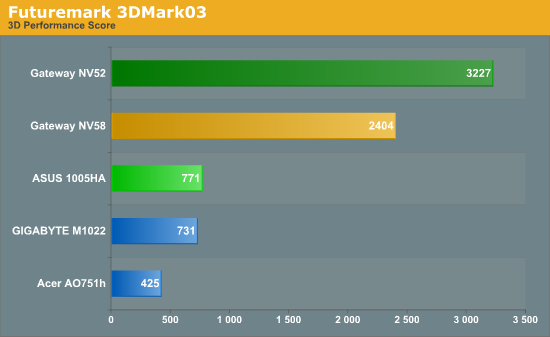
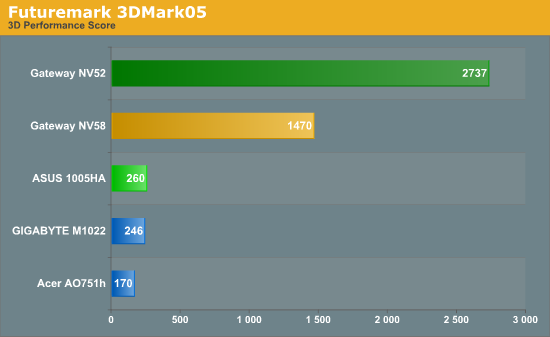
If general performance was bad, 3D performance is even worse. 3DMark03 -- a benchmark that focuses primarily on DirectX 8 performance -- has the GMA 4500MHD outperforming the outdated GMA 950 by 212%, and AMD's HD 3200 comes in 319% faster. Switching to a more modern DirectX 9 benchmark, 3DMark05 gives the 4500MHD a 465% advantage and the HD 3200 is nearly ten times as fast (953% faster). If you're planning to try to run any 3D games on these netbooks, you will definitely want to stick with older titles. The original Half-Life should work okay, for example, along with other games from 2000 and earlier. 2D titles should present fewer difficulties… Diablo 2 for example is a good option.
For those interested in other tasks, we were able to watch Hulu.com (360p) movies in fullscreen mode without difficulty. Standard YouTube videos also work fine -- in fact, here's one case where the low 1024x600 native resolution is actually a bonus. HD Hulu and YouTube videos are a different matter, with serious performance issues to the point where they are unwatchable. It's not clear if this is a limitation of the graphics chip, the Atom processor, or Adobe Flash -- or all of the above. As you can imagine, higher quality QuickTime videos (i.e. with H.264 encoding) are also a problem as there's simply not enough oomph to decode them properly. Stick with less complex codecs, however, and the 1005HA works well as a portable video device.
In contrast, the higher performance AMD and Intel laptops from Gateway have no problem with HD YouTube and other web content. H.264 playback is also possible, though the NV58 couldn't handle 1080p x264 content while the HD 3200 in the AMD system manages that task... and do we even need to mention how much better the NV52 is at gaming? Higher bitrate x264 videos aren't a serious need on netbooks, however, particularly those with 1024x600 LCD panels. Such videos may be nice to watch if you have them, but there's also the question of battery life when watching movies. As we'll see on the next page that's one area where the netbooks really trump regular laptops. Without further adieu, then, let's move on to battery life testing.










41 Comments
View All Comments
GeorgeH - Friday, August 21, 2009 - link
Thanks for those perspectives, they're much appreciated. I should probably just go buy one and judge for myself, but $200+ for another doorstop is a little steep. :)I guess for the time being I'll just stick with LGA775/AM2 for my low end needs.
JarredWalton - Thursday, August 20, 2009 - link
Honestly, employees get paid so much more than the computers they use (in all but a few situations) that there's no way I'd recommend "going green" by using Atom-based systems. Let's just estimate that computer-related tasks end up taking 10% more time on average (because multitasking is going to be more limited on such PCs). If you pay someone $20 per hour, you've now wasted $16 per day per employee.Even if it's only 5% and $8 per day, considering a 200W PC uses around $0.16 in electricity during an eight hour shift, cutting that down to an 8W netbook and spending a penny a day on power means that your net costs have still gone up $7.85 per day or more based on lost productivity.
Unless you're power constrained (i.e. in a data center), I think the whole green movement is just a bunch of marketing and political mumbo jumbo. Other "green" CPUs like Core 2 Duo would be far more effective at saving money over the course of the year.
Then again, the biggest source of lost money for companies is probably employees wasting time rather than waiting on their PCs. :-)
yyrkoon - Thursday, August 20, 2009 - link
"Dont expect to spend sub-$400 (not yet anyway) and still expect all the sweet things most commenters are asking for here"I did exactly that, 3 month ago. But it was not a netbook, it was a full blown laptop, even if low powered. $399, free shipping. But, I did add to the cost by having enough foresight to order a 4GB upgrade for it ( $50 ). It will definitely not win any speed records, but at least it *will* run Photoshop, play video without skipping a beat,and play game titles such as GTA San Andreas, or Titan Quest with no problems. All while using a maximum of 40W full load. Idle is only ~17W. Battery life is only ~2 hours, unless you turn it down to energy conservation mode, but that does not bother me one bit. As a matter of a fact, playing no games, and turning the power option down, I have had it last 8-9 hours, but I was not constantly using it like I often do while gaming.
Also, at the same time I was looking at an Asus C2D system, with 4 GB RAM, and one of the newer 512MB/1GB N120 nVidia dedicated graphics cards in it. It was not sub $400, but it was sub $800. This is something that I personally did not ever expect to see, and wished at the time - I had the cash to divert towards. Sadly, I could not :(
Anyhow, this all just lends to what I have been thinking ever since netbooks have been on the market. Which is: "Why even bother". You can get a decent laptop, for close to, or the same price, and get much better performance for your price. These laptop also may not be built like an M1 Abrams, but if you're careful with them, they will last a good long time.
qwertymac93 - Thursday, August 20, 2009 - link
im just waiting for amd's 45nm notebook chips, or at least their dual core neo's. the ones used by hp are custom, i want dual cores for everyone! is it too much to ask for a sempron 140 that uses 10watts or a 240 that uses 25?BigLan - Thursday, August 20, 2009 - link
It looks like the xvid and x264 pass 1 charts have got mixed up - I'd be really suprised in any of the laptops could only manage single digit xvid encoding.JarredWalton - Thursday, August 20, 2009 - link
The x264 encoding graphs are correct; there are no Xvid encoding results - I assume you mean the DivX results? x264 is much more complex than DivX, true, and the second pass in particular can take a very long time. However, the x264 encoding results are for a 720p video (graysky x264 HD Benchmark) while the DivX results are for a 1080p file (done in single-pass, quality-based, preset of 5). The settings and video source definitely have an impact on how quickly DivX encoding will run; a regular single-pass DVD encode is going to be about four or five times as fast in DivX. I'll add the video file information to the charts for clarification.Mithan - Thursday, August 20, 2009 - link
These netbooks are all fine and dandy, but they still have not made one I want.What do I want?
-1.6Ghz+ CPU
-11-12"
-Higher than 1024x600 resolution (1366x768?)
-Preferably an ION chipset, but I can still live with the 950.
There are a few 11-12" Netbooks on the market, but they all have that crappy 1.2Ghz Celeron or ZA520 chip or whatever it is called.
No, I dont want a 15" Laptop, even for the same price.
I guess the wait goes on...
Voldenuit - Friday, August 21, 2009 - link
What about CULV C2Ds and Athlon Neos? Ultraportable, ultrapowerful and ultraaffordable.qwertymac93 - Thursday, August 20, 2009 - link
ever heard of the samsung nc20? its via chip is actually a little faster then the atom n270 despite its low clock speed. the only drawback is its $100 more then most atom notebooks, but it does have a 12 inch screen!Visual - Thursday, August 20, 2009 - link
Well I am a bit more hard to satisfy than you then. the 950 is definitely not enough, i'd not say that even for the GMA 4500... but at least it would have been a step in the right direction.I also am ready to pay a bit more to have it convertible with a simple touchscreen... and pay even double if it were a really good touchscreen - at least 1024 pixels in vertical for adequate portrait operation, with multitouch, decent amount of pressure levels, both pen and finger sensitivity and ability to distinguish between the two.
Bonus points (and price) if it also distinguishes between the two sides of the pen or has a button or two on it, though buttons on the screen bezel can do the trick as well - they just need to be accessible in tablet mode. I think they are a must-have for emulation of hover functionality, where you're not forced to click and/or drag every time you touch the screen to move the "mouse" somewhere - anyone that has ever used a touchscreen probably understands this, so I really can't believe it's not a standard feature of every tablet by now.